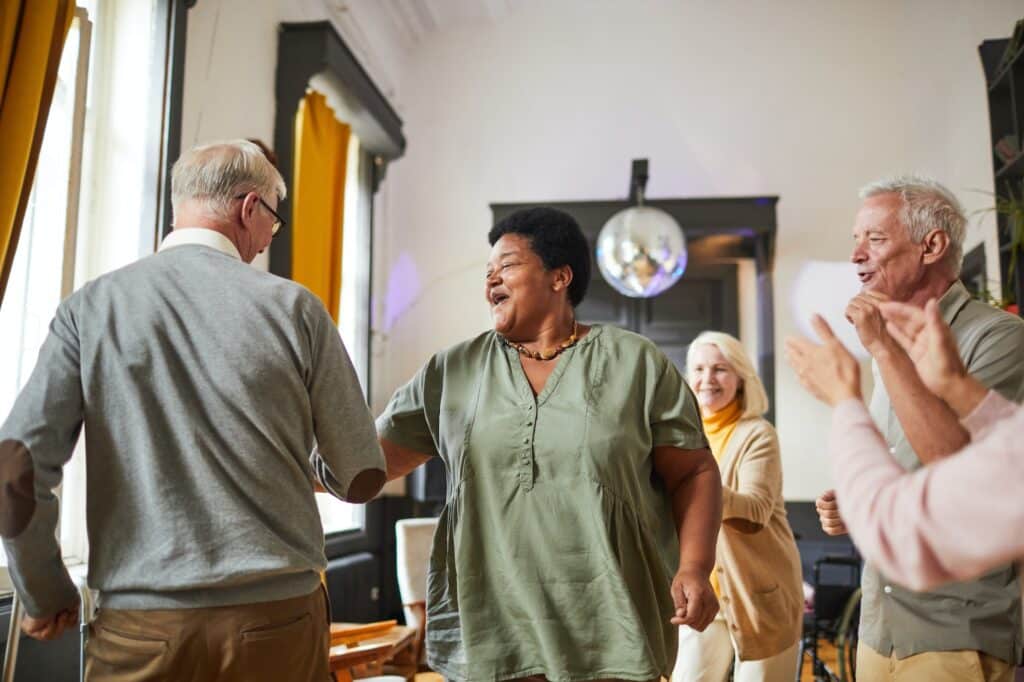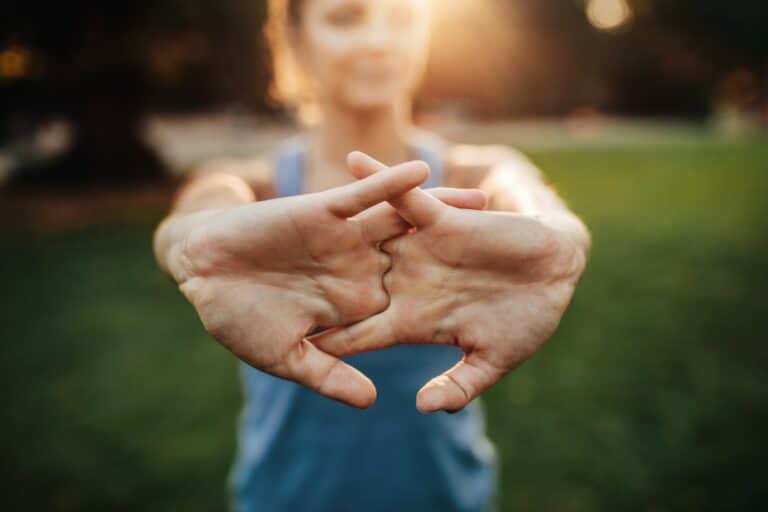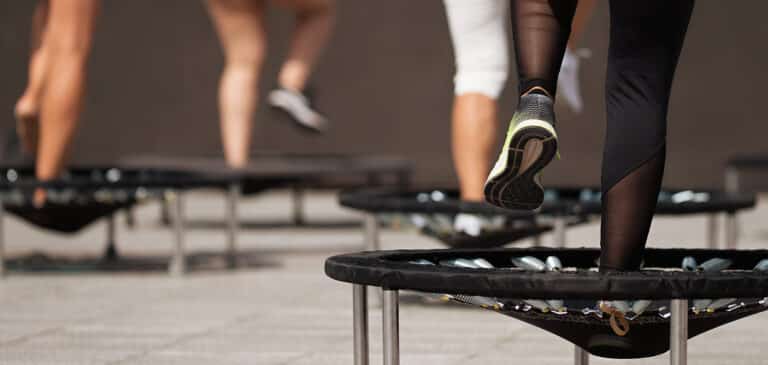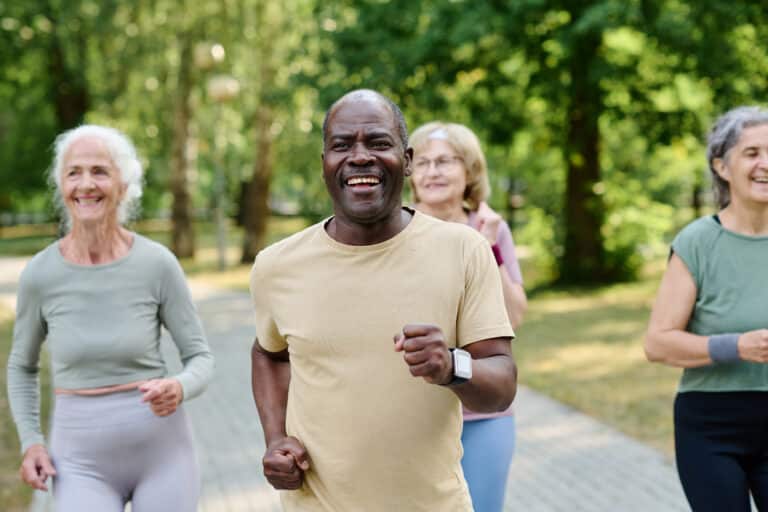Dance has been around since the beginning of time, as a form of self-expression, storytelling, and celebration. But did you know it can also be a fun way to boost your overall health? Dance can be made to fit your abilities to challenge you physically and mentally. It’s also a fun movement practice that you can enjoy with friends at a gym or community center, or even in your own home.
The benefits of dance for your overall wellness include improvements in cardiovascular health, strength, flexibility, balance, mental health, and cognition. In this article, we’ll explore dance exercise for seniors as a way to improve your health in a fun and challenging new way.
One literature review examined the overall effects of dance exercise on older adults:
- 89% of studies demonstrated improvements in balance,
- 82% demonstrated strength and endurance improvements,
- 60% demonstrated improved flexibility.
Cognitive benefits have also been found following general exercise and dance exercise specifically. Let’s take a deeper look into how dance exercise can improve your health to leave you feeling stronger and more energized. (1)
Cardiovascular Health Benefits of Dance
Dance workouts can be a great form of safe, fun aerobic exercise, improving both endurance and heart health!
According to the Centers for Disease Control and Prevention, adults aged sixty-five and older should try to participate in “moderate-intensity cardiovascular activity” for 150 minutes per week to reduce the risk of cardiovascular disease and other age-related conditions.
After twelve weeks of dance exercise, one study found participants had a lower resting heart rate and improvements in endurance during a timed walking test. (3)
Typical dance classes keep you up and moving for the majority of the class which could vary in length from twenty to sixty minutes. This combination can improve aerobic endurance while also raising your heart and breathing rate to get closer to the CDC’s recommendations for daily activity.
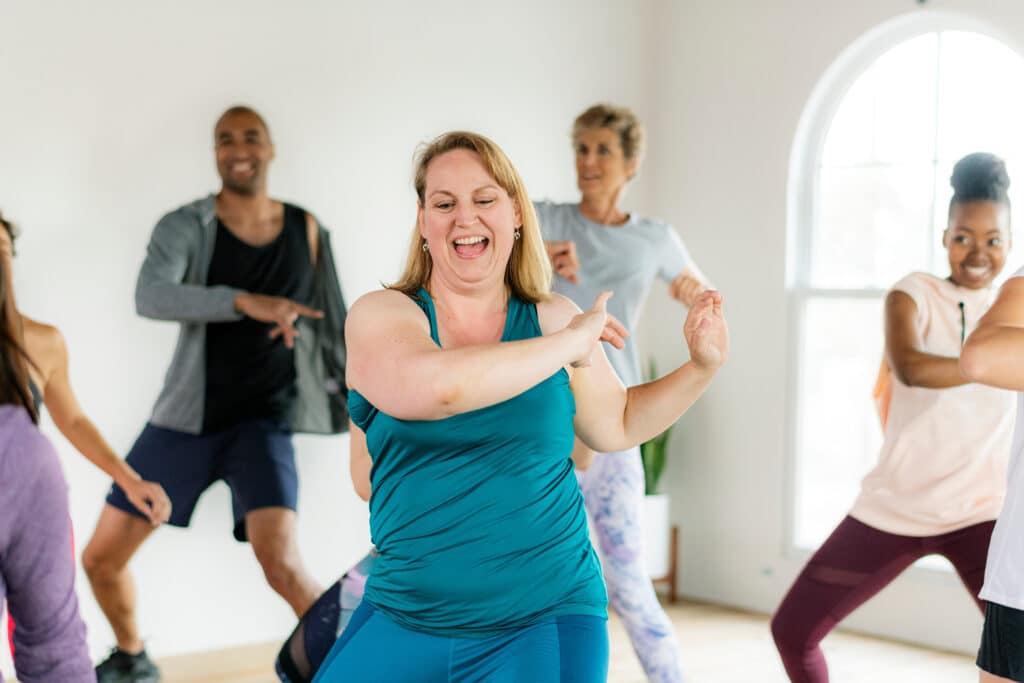
Strength Benefits of Dance
Dance exercise can also improve muscular strength and bone health.
Dance is also considered a “functional” movement since it incorporates many patterns like squatting, bending, and standing on your toes in repetition. These movements can be a great way to build strength in the muscles of your legs.
Much like a muscle, bone density improves during moderate-intensity activities that build strength. It is important for seniors– especially those with osteoporosis– to participate in low-impact strengthening activities to promote bone health.
A dance workout requires continuous weight bearing through the lower body, making it a great option for improving bone health and building strength in the muscles of your lower body.
Improving strength can also make simple daily activities feel a little bit easier. For example, 50% of older adults who completed dance exercise classes showed less effort in their ability to stand from a chair compared to performance prior to dance classes thanks to improved leg strength. (4)
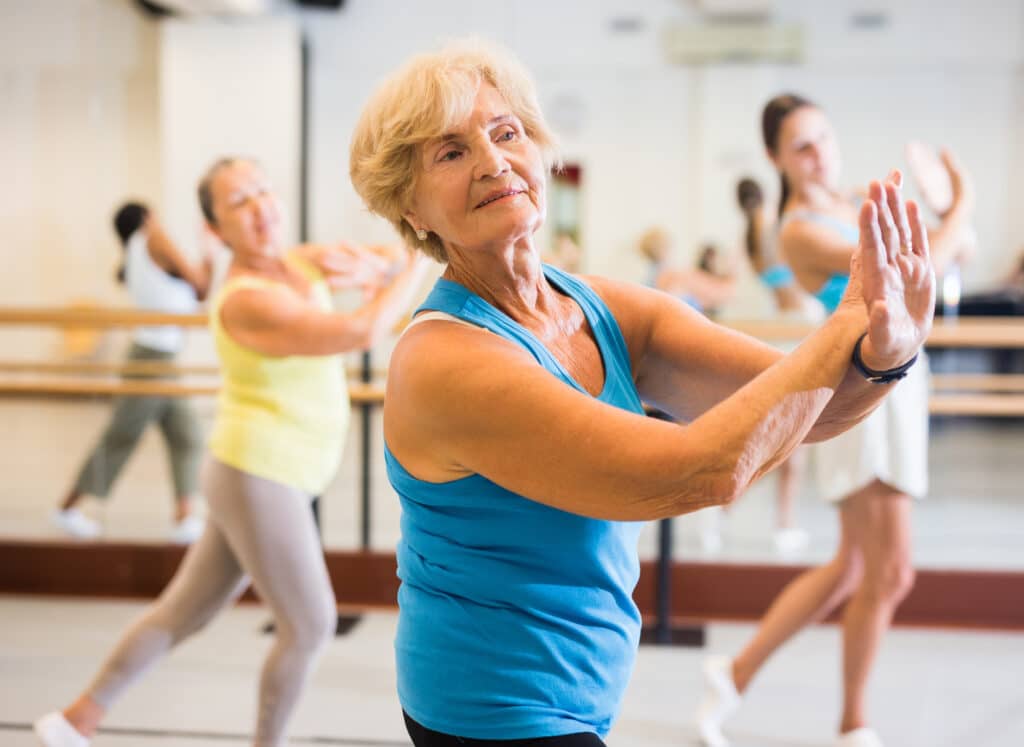
Balance Benefits of Dance
Dance can help you work on your balance in a way that is fun and interactive.
For many older adults, reduced balance can lead to higher fall risk and decreased participation in activities. For safety with everyday tasks, it is essential to have both good static and dynamic balance.
- Static balance is required for activities when you are standing still while.
- Dynamic balance is essential whenever you are moving.
Both types of balance require coordination from several parts of your brain and body, including your eyes, your feet, and even your inner ears.
These various parts of your body interpret where your body is in space so that it can maintain stability. Good balance will keep you safe when you are standing still or when you are moving so that you can react to changes in your position without risk of falling or other injuries.
Research has found significant improvements in seniors’ ability to stand on one leg, and improved balance while walking after participating in regular dance classes. Another study found that after line dancing for thirty minutes twice per week for six weeks, participants improved by up to 26% on balance tests. (4)
Dancing incorporates both dynamic and static balance challenges to develop improved posture and better coordination, safely.
Dancing can be a great way to practice a variety of movements. In a dance class, you might find yourself standing or walking on your toes, standing on one foot, quickly changing directions, shifting your weight from one foot to another, turning your head, or pivoting.
Just like building muscular strength, your balance will improve with practice, and dancing is a great form of balance practice while exercising.
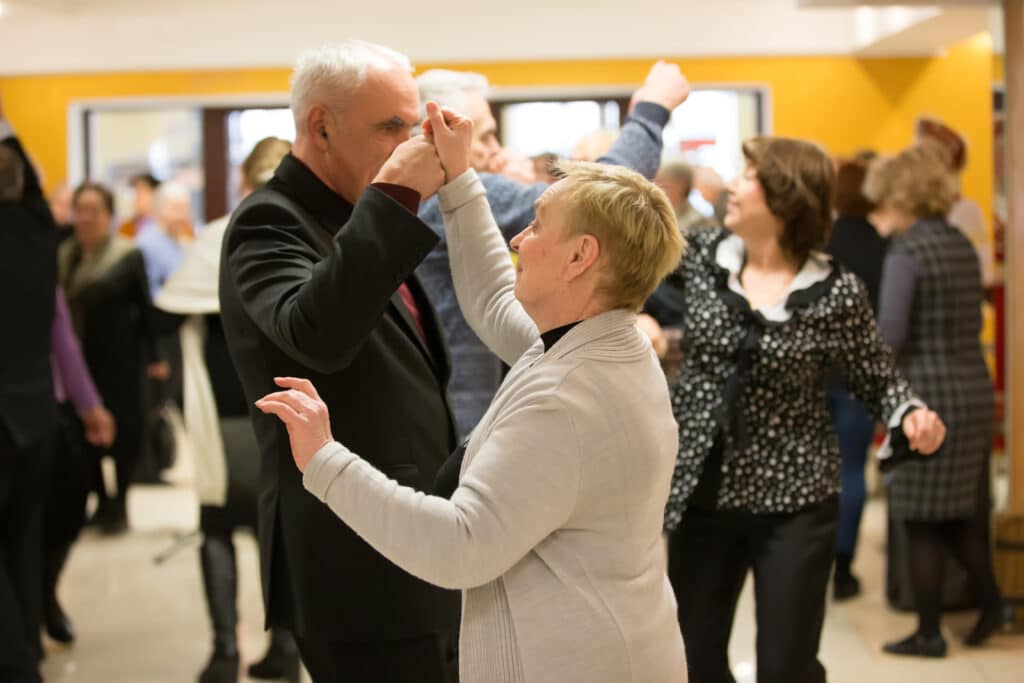
Mental Health and Cognitive Benefits of Dance
Cognitive decline can be nearly twice as common in older adults who are inactive compared to active adults. Exercise is essential for maintaining both physical and brain health. (6)
Physical activity can improve the function of the brain to reduce cognitive decline. Dancing requires the use of memory and spatial awareness to coordinate movements, especially in a group setting. (6)
Studies have also examined how dancing can affect mood. In a study looking at the effects of line dancing, participants reported reduced tension, depression, fatigue, and anger after just one 75-minute session. (5)
Music alone can be therapeutic for your mood and stimulate your memory for greater brain function. Music can also assist you with maintaining rhythm while motivating you to keep moving. (5, 7)
Finally, dance exercise provides social interactions in group settings, and allows for creative self-expression. This can be especially beneficial for those with dementia or aphasia who have difficulty verbally communicating, allowing them to effectively communicate their feelings and frustrations through movement. (7)
Dancing is an effective way to engage with friends in your community, while you improve both your fitness and your mental health.
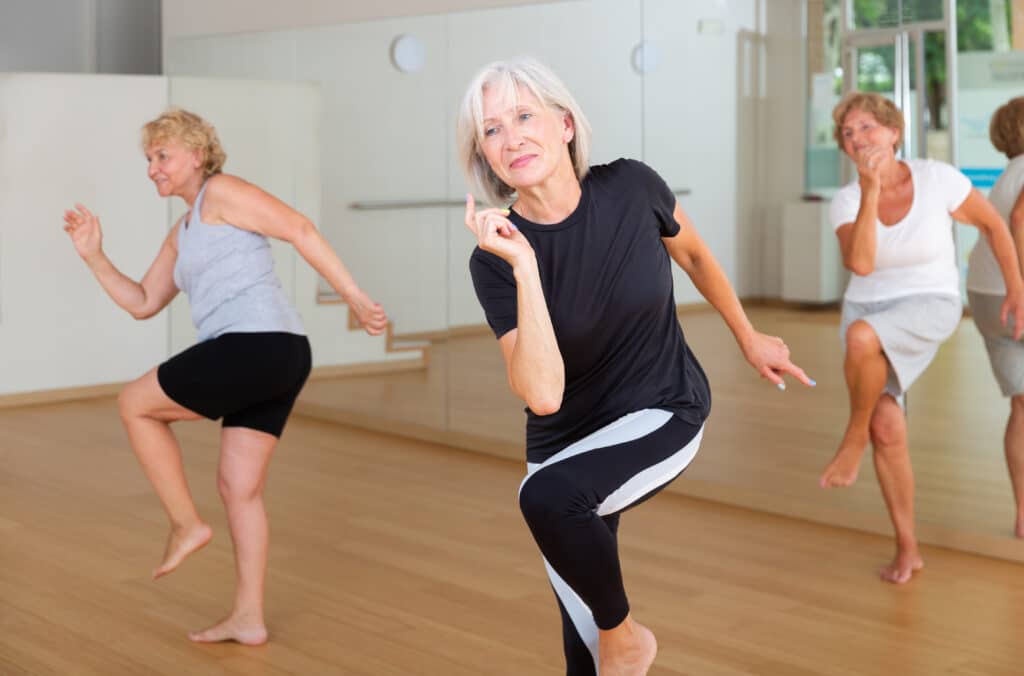
Getting Started: Dance Classes for Seniors
Before starting a new exercise class, be sure to talk with your doctor, especially if you have any known health concerns. Many times modifications can be made to accommodate your specific experience and ability.
You may already have access to dance classes to get started in your area!
If you are over the age of 65, Medicare allows free access to Silver Sneakers programs, which feature a dance class called “Jazzercise.” Another popular dance class is “Zumba” which features classes for all ages, including an older adult-focused class called “Gold.” Often, local dance studios may offer specific classes for older adults or beginners classes for all ages.
You can also visit our Physio Ed Youtube page to browse our collection of free classes, both dance and otherwise.
Finally, if you have danced before and you’re simply looking for groups of like-minded seniors, it may also be helpful to check Facebook, Meetup, or other online community activity boards in your area. If you feel comfortable with these options, they may provide new opportunities to meet with privately organized groups in your area.
And of course, you may not even need a video – it never hurts to just put on some of your favorite music to dance to in your own home!
Conclusion:
We hope this article has illustrated how dance can benefit your physical and mental health. Many studies have demonstrated varied benefits for your heart, your muscles, and your brain. The health effects of exercise as a whole are very well known, but dance can offer a fun and social means to achieving getting in shape and feeling great!
References:
- Hwang, P. W., & Braun, K. L. (2015). The Effectiveness of Dance Interventions to Improve Older Adults’ Health: A Systematic Literature Review. Alternative therapies in health and medicine, 21(5), 64–70.
- Centers for Disease Control and Prevention. (2021, May 21) Physical Activity Boosts Brain Health. https://www.cdc.gov/nccdphp/dnpao/features/physical-activity-brain-health/index.html#:~:text=Not%20only%20is%20it%20good,and%20reduce%20anxiety%20or%20depression.
- Hui E, Chui BT, Woo J. Effects of dance in physical and psychological well being in older persons. Arch Gerontol Geriatr. 2008;49(2008):e45–e50
- Sooktho, S., Songserm, N., Woradet, S., Suksatan, W. A Meta-Analysis of the Effects fo Dance Programs on Physical Performance: Appropriate Health Promotion for Healthy Older Adults. Annals of Geriatric Medicine and Research. 2022; 26(3):196-207.
- Welder, Sara. (2001) “The Effects of Line Dancing on Balance and Coordination in the Elderly”. Physical Therapy Scholarly Projects. 468. https://commons.und.edu/pt-grad/468
- Omura, J. D., Brown, D. R., McGuire, L. C., Taylor, C. A., Fulton, J. E., & Carlson, S. A. (2020). Cross-sectional association between physical activity level and subjective cognitive decline among us adults aged ≥45 years, 2015. Preventive Medicine. 141: 106279. https://doi.org/10.1016/j.ypmed.2020.106279
- Wang, Han. “The Effectiveness of Dance Movement Therapy with Elderly Women Who Have Dementia” (2019). Expressive Therapies Capstone Theses. 230. https://digitalcommons.lesley.edu/expressive_theses/230

